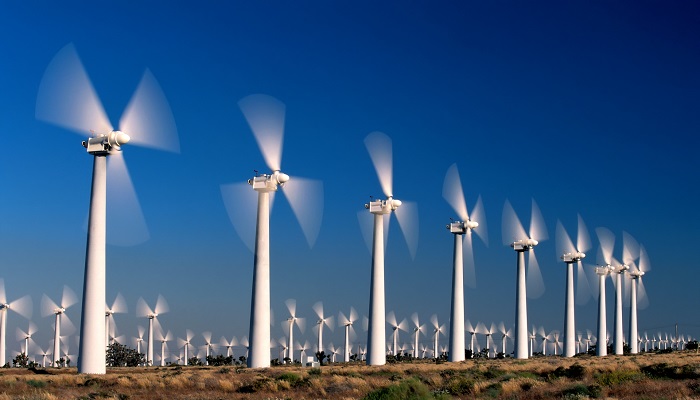Wind energy (or wind power) is a form of renewable energy that uses airflow to generate electricity.Wind turbines are typically about 120 metres high to capture stronger winds and their blades span about 45 metres. A single small wind turbine can generate electricity for a single home, while many larger turbines lined up together on wind farms can generate electricity for the grid. The wind turns the blades of a wind turbine that is connected to a generator, and the generator converts the wind’s kinetic energy to electricity.Energy is one of the most important factors of National development. Nigeria currently generates energy from different hydro-power and thermal power stations. The major seasons are wet and dry. The seasonality makes the extent of water availability at the different hydro-power stations variable, leading to intermittent supply at times of low water levels. Also, the thermal power stations have been bedeviled by lack of adequate supplies of natural gas from the various Niger Delta gas wells, thereby making continuous energy production from these installations difficult. As at 2001, about 25% of the 774 local government areas of Nigeria were not connected to the national grid and today, more than 80% of these areas are still not connected; a national projection based on 13% Gross Domestic Product growth rate revealed that energy demand will increase from 5746 MW in 2005 to 297900 MW in 2030 while supply should increase from 6440 MW to above 300,000 MW within the same period of years. To accomplish this, requires an additional 11,686 MW every year to meet demand. Nigeria currently generates an estimated 3000 MW due to fluctuations in the availability and poor maintenance of generating equipments. Thus, Nigeria still has a long way to go in achieving energy sufficiency. Furthermore, the present generation mix needs augmenting with the aim of maximizing sustainable energy production.
Access to stable power is an enormous challenge facing Nigeria today and despite allocating large chunk of funds to improve power supply in the country, little or no achievement has been made. Today, 60% to 70% of the Nigerian population does not have access to electricity. There is no doubt that the present power crisis afflicting Nigeria will persist unless the government diversifies the energy sources in domestic, commercial, and industrial sectors and adopts new available technologies to reduce energy wastages and to save cost. The world is looking at various means of generating energy. Recently in Germany, a stormy weekend led to free electricity in Germany as wind generation reached a record, forcing power producers to pay customers the most since Christmas 2012 to use electricity. Power prices turned negative as wind output reached 39,409MW, equivalent to the output of about 40 nuclear reactors. To keep the grid supply and demand in balance, negative prices encourage producers to either shut power stations or else pay consumers to take the extra electricity off the network.
How viable is generation of wind energy in Nigeria?
Various research carried out identified that great prospects exist for wind energy utilization for power generation. Moreover, wind speeds are generally weak in the south except for the coastal regions and offshore, which are windy. Offshore areas from Lagos through Ondo, Delta, Rivers, Bayelsa to Akwa Ibom States were reported to have potentialities for harvesting strong wind energy throughout the year. Inland, the wind was reported strongest in the hilly regions of the North, while the mountainous terrains of the middle belt and northern fringes demonstrated high potential for great wind energy harvest. It was however observed that, due to varying topography and roughness of the country, large differences may exist within the same locality. Also, results from The Nigerian Metrological Agency based on the outcome of using 40 years (1968 − 2007) available average wind data from the whole forty-four wind stations across the states of the federation showed that the country’s wind regime is found to lie majorly between poor to moderate regimes, with the southern states having their mean wind profile at 10 m height in the range between 3.0 − 3.5 m/s, depending on the states, and Northern states capable with mean wind speeds of between 4.0 − 7.5 m/s. This means that, Nigeria has good wind resources over most part of the country. Although, wind speeds in the southern states are low, they can however be employed for standalone power generating systems using small scale wind turbines. This if employed, will be a major breakthrough for rural and sub-rural areas not connected to national electricity grid.
Way Forward.
The Federal Government needs to develop a robust policy framework of legal and regulatory mechanisms that would encourage the development of wind energy technology, attract foreign and indigenous investors and also set standards for wind farm creation and management. As at today, no popular fiscal, legal or regulatory policy exists for WET. Potential investors always will hope to see the level of seriousness which the governments have demonstrated and what opportunities have been put in place to enhance marketability of WET within the country before investing in their money.
Basic researches into the act of tapping wind for electricity have been non-existent within the country. This is because, such practices involve funding and such funds have not been available anywhere for access by wind energy researchers. Even though only few results are available on the prospects of wind energy in Nigeria, none of them have created representative models that can be used to evaluate or forecast at any time the amount of wind energy and wind power fluxes per annum that will correspond to particular sets of wind speeds for the nation. The development of such models will be based on historical wind data for different sites and states across the nation and through regression and other statistical distributions, a predictive model which can be used at any time for forecasting the wind power situation of a place can be successfully developed.
Lastly, Nairametrics is of the opinion that more efforts should be channeled towards tapping the huge potentials available in Wind Energy Generation. Resolving Nigeria’s Energy crisis requires looking at other sources of generating power cheaply and environment friendly.
Fikayo Owoeye writes for Nairametrics










![[The Nigerian Economy Daily] FG has approved the closure of five foreign missions and embassies](https://nairametrics.com/wp-content/uploads/2017/05/nigerian-economy-today-1.jpg)










Nice and informative writeup Fikayo. Many thanks.